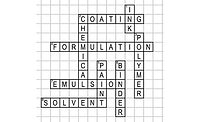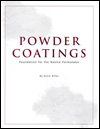The Solution to Saul’s Double Rub Debacle

Editor’s note: As we read in PCI’s October issue, Saul Vance had formulated a coil coating formulation that passed MEK double rubs in the lab when formulated with a fluorosurfactant flow control additive. But, when this additive was replaced with an acrylic flow control additive on the coil line, the formulation didn’t pass MEK (Methyl Ethyl Ketone) double rubs. Why did this change result in poor MEK double rub results? How did Saul’s boss, Wyatt Walsh, know that Saul’s formulation didn’t have the required crosslink density?
Saul Vance had developed the formulation over the previous three months in his lab and used a very simple formulation. The polyester resin was one that Big Time Paint had made for years. The only other ingredients were the standard melamine crosslinker, catalyst and TiO2 pigment.
Coil coating formulations have to balance excellent flexibility with excellent crosslink density. The coating should not crack when bent upon itself, known as a zero t-bend. Yet, the coating has to have good solvent resistance as measured by the MEK double rub test. Saul worked hard to balance these properties by optimizing the levels of each of the ingredients in the coating. He calculated the correct molecular weight of the polyester, the correct hydroxyl functionality of the polyester, and the amount of melamine and catalyst to give a consistent crosslink density.
Saul had formulated the coating to pass the same test protocol that his customer would use: MEK double rubs to measure crosslink density, pencil hardness to measure surface hardness and T-bends to measure flexibility. Like MEK double rub testing, pencil hardness and T-bend testing were fast and easy tests that coil coaters use on the line. The hardness had to pass a minimum to prevent marring on the line, especially when the coil was rewound and shipped to the customer.
Saul had also included a small amount, only 0.5%, of a fluorosurfactant, to overcome surface defects and help flow out on the coil line. Wyatt Walsh realized that the MEK double rub test was giving a false positive test because of the addition of the fluorosurfactant additive.
The problem is that the double rub test is only a good quantifiable test if the MEK is a good solvent for the coating and behaves the same way for all coating systems. The test only works if the MEK wets the surface of the coating, penetrates the coating and swells the cross-linked polymer. If there is enough crosslink density in the coating, the MEK will not remove the coating upon rubbing with the cheesecloth.
Wyatt knew the fluorosurfactant was acting as a very efficient barrier to the MEK penetrating the polymer. Fluorine-containing surfactants are used as additives in coil coating formulations because they overcome many of the flow problems seen on high-speed coil lines. However, the fluorosurfactants impart very low surface tension to the coating, especially when they migrate to the surface during curing. At the surface of the film, the fluorosurfactants stop the MEK from penetrating the coating film and swelling the polymer. Besides imparting low surface tension, the fluorosurfactants make it difficult for the MEK to wet out the surface because of their inherent insolubility in most solvents.
On the coil line, without the fluorosurfactant additive in the formulation, the MEK was able to swell and attack the film. In the QC lab, the MEK double rub testing was demonstrating that the coating didn’t cure to the extent needed by the coil coater.
In addition to giving a false positive MEK double rub test, the fluorosurfactant was improving the slip resistance of the coating. When Saul ran hardness of the coating by checking pencil rubs, the fluorosurfactant allowed the pencil to slip across the surface without biting into the surface. The fluorosurfactant was not allowing the pencil to mar the coating. In the lab, Saul was getting pencil hardness units indicative of a good cure and getting another false positive test.
If Saul had taken the time to determine the true crosslink density of the coating by running one of the many analytical tests available to determine crosslink density, he would have seen that the formulation wasn’t curing sufficiently. But these tests are time-consuming, often take specialized equipment, require trained personnel to interpret, and are often difficult because the film has to be analyzed free from the substrate.
The addition of this one additive had generated two false positives in his coating testing. Wyatt insisted that Saul test the cure without the flow additive and then, if acceptable, check again with the flow additive.
After Saul spent the next two weeks reformulating his system and doing the appropriate crosslink network analysis, Wyatt thought it appropriate to mark the occasion with a small token to recognize Saul’s hard work. Wyatt came into Saul’s office holding a small toy, a Rubik’s cube, as a gift. Wyatt held the toy in his hands and said, “This toy is a good example of the difficulties involved in formulating coatings. A single, seemingly insignificant, change in one ingredient, one additive, in a coating formulation can sometimes greatly impact the properties in ways difficult to predict.” As he spoke, he took the Rubik’s puzzle in both hands and twisted the cube 90 degrees, showing Saul the face that now had all the same color. Wyatt continued, “much like how twisting the cube can result in moving the correct color to one face, while simultaneously changing the colors on the other three faces in unpredictable and sometimes detrimental ways.”
Looking for a reprint of this article?
From high-res PDFs to custom plaques, order your copy today!









